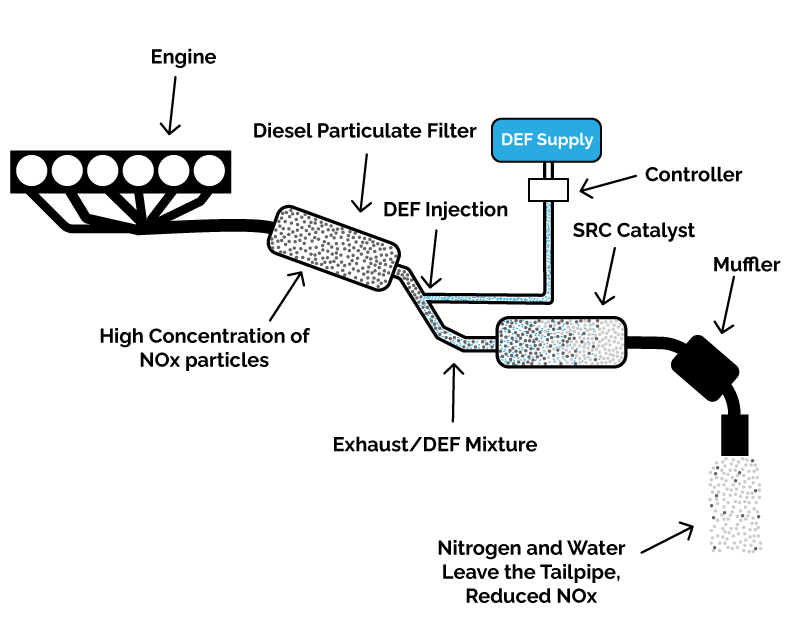Diesel Exhaust Fluid (DEF): An Essential Component for Modern Diesel Engines
Diesel Exhaust Fluid (DEF) has become an integral part of modern diesel engine systems. This blog post will explore what DEF is, its properties, how it works, its implementation in various makes, handling, and disposal.
What is Diesel Exhaust Fluid?
DEF is a liquid solution made from a mixture of urea and deionized water. It’s typically colorless, though it can sometimes have a slight tinge of color due to the urea. This fluid plays a crucial role in reducing the amount of nitrogen oxide (NOx) emitted by diesel engines, which is a significant pollutant.
Diesel Exhaust Fluid (DEF) is essential for maintaining emission standards in vehicles. However, its effectiveness can be compromised if it’s contaminated with other common vehicle fluids, including water. This contamination can lead to damage in system components and impair the fluid’s ability to reduce emissions.
- Color Changes Due to Metal Contact: Normally, DEF is clear. However, it can change color when in contact with certain metals. If DEF comes into contact with copper or brass, it may turn light blue. Conversely, contact with steel or galvanized steel can give DEF a rusty appearance.
- Density Differences with Other Fluids: DEF is denser than both diesel fuel and oil. As a result, if these fluids are mixed with DEF, they will tend to float on top, indicating possible contamination.
- Odor: DEF has a characteristic slight ammonia smell. Any noticeable deviation from this odor can suggest contamination.
- Testing the Fluid: In cases where contamination is suspected but not evident through color or smell, further testing is advisable. This can be done using a refractometer to analyze the fluid’s properties. Additionally, some vehicles are equipped with the capability to conduct a DEF quality test using a scan tool.
How Does DEF Work?
DEF is used in a process called Selective Catalytic Reduction (SCR). In SCR systems, DEF is injected into the exhaust stream of a diesel engine. When DEF enters the hot exhaust gases, it vaporizes and decomposes into ammonia and carbon dioxide. Then, when these gases pass over a catalyst, the ammonia reacts with the nitrogen oxides in the exhaust and converts them into nitrogen and water, which are harmless and naturally occurring in the atmosphere.

When Did Various Makes Start Using DEF?
The adoption of DEF has been largely driven by increasingly stringent environmental regulations. In the United States, the Environmental Protection Agency (EPA) implemented stricter emission standards for diesel engines, leading to the widespread use of DEF in vehicles manufactured after 2010. European and other global standards followed similar paths. Specific adoption timelines can vary by manufacturer and region, its important to be mindful of your diesel engines performance.
Where Do You Put DEF?
DEF is stored in a separate tank in a diesel-powered vehicle, equipped with its own filler cap. This cap is often labeled “DEF” and is typically located near the fuel filler, in the trunk, or under the hood, depending on the vehicle’s design. It’s crucial not to mix DEF with diesel fuel.

DEF Tank
Can DEF Freeze?
Yes, DEF can freeze. It has a freezing point of approximately 12 degrees Fahrenheit (-11 degrees Celsius). However, vehicle systems are designed to handle this. When DEF freezes, the vehicle can still start and run, and as the engine warms up, the DEF will thaw and function normally.
Is DEF Toxic?
DEF is not toxic, but it can be mildly irritating to the skin, eyes, and respiratory system. It’s advisable to handle it with basic safety measures, like gloves and eye protection, and avoid ingestion.
Is DEF Flammable?
No, DEF is non-flammable. The urea-water solution does not pose a fire hazard, which is a significant safety benefit in handling and storage.
Where to Dispose of DEF?
Proper disposal of DEF is essential. While it’s not classified as a hazardous material, it shouldn’t be poured into the environment or down a drain. Old or contaminated DEF should be disposed of at a designated recycling center, service station, or a facility equipped to handle automotive fluids. It’s also important not to reuse old DEF containers for other purposes, as the residual urea can contaminate other substances. Find an oil and automotive liquid disposal in British Columbia here.
Conclusion
Diesel Exhaust Fluid is a key component in modern diesel engines, helping to significantly reduce harmful emissions. Understanding its properties, how it works, and how to handle and dispose of it responsibly is crucial for anyone operating or maintaining a diesel-powered vehicle. By following proper handling and disposal procedures, vehicle owners can contribute to a cleaner environment while ensuring their vehicles run efficiently and comply with emission standards.
Reach Us
Office Hours
Mon – Fri | 8:00am – 5:00pm
Sat – Sun | Closed


